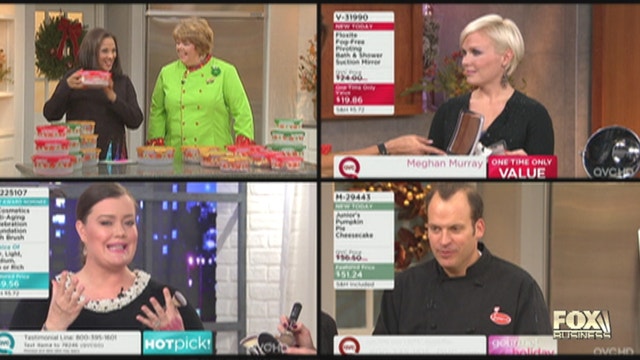The QVC Effect
Christina Scotti reports from QVC headquarters in West Chester, Pennsylvania: a look at the business behind it, how it affects the businesses that are featured on it -- and the all-important question: how do you get your business on QVC?
It’s live 24 hours a day, seven days a week. It has 22,000 on-air guest appearances every year. It’s seen in more than 100 million homes in the U.S. and in a few hundred million across the globe.
It’s a place where if you’re lucky enough to get on, you can give your business exposure that many entrepreneurs can only dream of -- and it’s all located in the small town of West Chester, Pennsylvania. Now, if you have a preconceived notion about the customer base and the items being sold on QVC, you may want to tune in because it’s surprisingly current, with guests like Jennifer Hudson and the Kardashians and brands from Apple to Ugg to Ralph Lauren.
Last month, rap star and entrepreneur 50 Cent made news last month when he sold over $170,000 worth of headphones in just nine minutes.
“We think one of our biggest strengths is being a storyteller and being able to enable a brand to speak to what differentiates it in the marketplace,” said Doug Rose, senior vice president for programming and marketing at QVC.
He said it’s the channel’s ability to humanize a business that engages customers. And there is no denying that they are doing something right: With the exception of 2009 at the height of the recession, it’s seen positive growth since going on the air 26 years ago.
It’s shipped over 160 million packages last year, and its global revenues were $8.3 billion. QVC is an empire that can give businesses exposure like nowhere else, but getting on the powerhouse channel is not easy.
“In addition to have a great story to tell, that’s not enough. We absolutely insist on every product that we offer going through a very stringent set of quality assurance standards,” said Rose. “And it’s not just how the product performs and can we substantiate the claims that product is seeking to make. But also how it ships....”
Vice president of production Scott Crossin gave us a tour around the massive 58,000 square feet of space. He said their approach is rooted in what they call the “backyard fence” approach; talking to the customer casually as if they were a neighbor. He also said with product prices ranging from $20 to $2,000, it’s all about giving the viewer variety.
Alan Rosen, the co-founder of New York’s iconic Junior’s restaurant and its famous cheesecake, knows a lot about the exposure that QVC can bring in both direct sales and name recognition.
“When you’re on TV, you get the chance to tell the story. When people go into our stores or walk by, they don’t get the whole back story and history,” he said.
And what a history it is. Rosen’s grandfather started the company on election day in 1950 and Junior’s, between Flatbush and Dekalb Avenues in Brooklyn became a New York institution. But Rosen said being on QVC took their story beyond its New York roots, transforming it into an internationally known business.
“Back in 1995, QVC was doing a search state by state for America’s best products,” said Rosen. “We showed up at the World Trade Center with six or seven hundred people and got selected as one of their 20 products to go on air. We went on for four or five minutes and sold 2,400 cheese cakes, which at the time was such a large amount for us.”
Fast forward seventeen years, it now sells an average of 150,000 cheesecakes on QVC every year and the company has exceeded $60 million in sales in 2012.
Startup It Cosmetics made many unsuccessful attempts at getting their products on the channel.
“I had been sending my products for a long time because I knew if I could show women how this works and show them live, it would be such a great platform for us,” said Jamie Kern, founder of the four-year-old beauty line. “So, I had sent them products for a few years and never got interest and then we were a cosmetics award ceremony with hundreds of brands. We had our concealer featured and… we met [QVC producers] and that’s what got us the chance….”
Now Jamie Kern, who has made over 200 guest appearances since first going on the channel in 2010 is expanding to a new office after her company tripled in size with revenues going from $2 million before launching on QVC to more than $40 million since being featured.
And still the big questions to business owners remain: What do you do to get on QVC?
“Start with passion which is rarely in short supply with entrepreneurs,” said Rose. “But beyond that – realistically, we are looking for products that are not at the idea state. We need products that are in the production stage…because our businesses can ramp up very quickly here….That’s the nice thing with QVC – if the customer is telling us that they’re liking this [product] and in particular if he or she is reordering it, we are very eager and quick to get on that reorder.”
And you realize after walking around this massive complex -- which feels like it’s own little world -- that needing to get that reorder fast is so important because satisfying the customer is at the heart of QVC’s business model, with 95% of all the revenues that they generate every year coming from people that buy with them more than once.
“If all we’ve done is convince someone to buy something, we’ve failed,” said Rose. “We have to make sure that we’ve delivered on the promise that we’ve made and better yet, tell their friends…”
